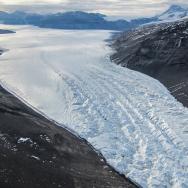Every year, earthquakes shake the ground and volcanoes erupt around the edges of tectonic plates—the massive pieces of Earth’s crust that slide slowly across the planet, creating and destroying mountains and oceans on the scale of eons. But the question of when this plate subduction actually began has been a hotly contested debate in earth sciences.
A new study from scientists at Scripps Institution of Oceanography at UC San Diego and the University of Chicago sheds light on this burning question. According to findings published Dec. 9 in the journal Science Advances, this process could have started 3.75 billion years ago, reshaping Earth’s surface and setting the stage for a planet hospitable to life.
For study lead author and Scripps Asst. Prof. Sarah Aarons, the clues to Earth’s earliest habitability lie in the elements that ancient rocks are composed of—specifically, titanium.
Aarons analyzed samples of Earth’s oldest-known rocks from the Acasta Gneiss Complex in the Canadian tundra—an outcrop of gneiss rocks 4.02 billion years old. These rocks are dated from the beginning of Earth’s formation, a time defined by hellish conditions and landscapes that would look alien to our modern eyes.
Plate tectonics and subduction zones are responsible for the way Earth looks, driving the creation of continental plates and the basins that would fill to become oceans. They are also the primary control on the chemical characteristics of the planet’s surface and are likely responsible for Earth’s ability to sustain life. These subduction zones are responsible for the formation of emerged continents and provide an important control on climate by regulating the amounts of the greenhouse carbon dioxide in the atmosphere.
But studying the history and onset of ancient subduction zones is notoriously difficult. Rocks are constantly destroyed as the crust is driven inward into the mantle, leaving behind few samples that date back into Earth’s earliest history. Scientists have long debated when plate tectonics and subduction began, with estimates ranging from 0.85 to 4.2 billion years ago—more than two-thirds of the planet’s history.
Aarons’ research focused on isotopes, which are variations of the same element based on the number of neutrons they have. She crushed bits of the gneiss rock into a powder that was then heated, cooled and dissolved in acid in order to chemically separate the titanium isotopes from other elements. Aarons was then able to determine the variations of titanium isotopes present in the sample using a mass spectrometer in the Origins lab led by her collaborator Nicolas Dauphas at the University of Chicago, where such measurements were pioneered.
‘‘These rocks went through the rocker in the 4 billion years since they were formed,” said Dauphas, the Louis Block Professor in the Department of Geophysical Sciences. “Titanium isotopes are invaluable to see through these processes and figure out the geological setting of magma generation at that time.”
Aarons compared these samples to newer, modern rocks formed in subduction zones. In four-billion-year-old rock samples, she saw similarities to modern rocks that are formed in plume settings, like Hawaii and Iceland, where a landmass is drifting over a hot spot. However, in rocks aged at 3.75 billion years, she noticed a shift in trend to rocks that are formed in modern subduction zones, suggesting that around that time in Earth’s history these areas began forming.
“While the trend in the titanium isotope data does not provide evidence that plate tectonics was happening globally, it does indicate the presence of wet magmatism, which supports subduction at this time,” said Aarons.
“A lot of previous work has been done on these rocks to carefully date them, and provide the geochemical and petrological context,” she added. “We were very lucky to get the opportunity to measure titanium isotope compositions, a burgeoning isotope system, in these samples.”
The technique used in this study could be applied to other ancient rock formations around the world to gain more information about the composition and evolution of Earth’s emerged lands through time, the authors said.
The Acasta Gneiss samples were provided by Jesse Reimink, an assistant professor at Penn State University. Nicolas Greber at The University of Bern (Switzerland) was also involved in the research.
Citation: “Titanium isotopes constrain a magmatic transition at the Hadean-Archean boundary in the Acasta Gneiss Complex.” Aarons et al, Science Advances, Dec. 9, 2020. DOI: 10.1126/sciadv.abc9959
Funding: National Science Foundation, NASA, Ford Foundation Postdoctoral Fellowship, Swiss National Science Foundation.
Adapted from an article first published by the Scripps Institution of Oceanography at UC San Diego and written by Chase Martin.

